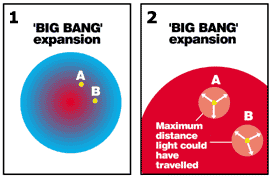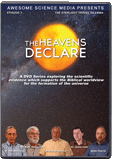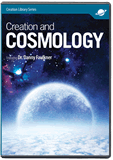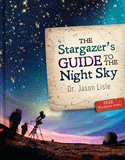Light-Travel Time: A Problem for the Big Bang
Originally published in Creation 25, no 4 (September 2003): 48-49.
The “distant starlight problem” is sometimes used as an argument against biblical creation. People who believe in billions of years often claim that light from the most distant galaxies could not possibly reach earth in only 6,000 years. However, the light-travel–time argument cannot be used to reject the Bible in favour of the big bang, with its billions of years. This is because the big bang model also has a light-travel–time problem.
The background
In 1964/5, Penzias and Wilson discovered that the earth was bathed in a faint microwave radiation, apparently coming from the most distant observable regions of the universe, and this earned them the Nobel Prize for Physics in 1978.1 This Cosmic Microwave Background (CMB) comes from all directions in space and has a characteristic temperature.2,3 While the discovery of the CMB has been called a successful prediction of the big bang model,4 it is actually a problem for the big bang. This is because the precisely uniform temperature of the CMB creates a light-travel–time problem for big bang models of the origin of the universe.
The problem
The temperature of the CMB is essentially the same everywhere5—in all directions (to a precision of 1 part in 100,000).6 However (according to big bang theorists), in the early universe, the temperature of the CMB7 would have been very different at different places in space due to the random nature of the initial conditions. These different regions could come to the same temperature if they were in close contact. More distant regions would come to equilibrium by exchanging radiation (i.e. light8). The radiation would carry energy from warmer regions to cooler ones until they had the same temperature.

(1) Early in the alleged big bang, points A and B start out with different temperatures.
(2) Today, points A and B have the same temperature, yet there has not been enough time for them to exchange light.
The problem is this: even assuming the big bang timescale, there has not been enough time for light to travel between widely separated regions of space. So, how can the different regions of the current CMB have such precisely uniform temperatures if they have never communicated with each other?9 This is a light-travel–time problem.10
The big bang model assumes that the universe is many billions of years old. While this timescale is sufficient for light to travel from distant galaxies to earth, it does not provide enough time for light to travel from one side of the visible universe to the other. At the time the light was emitted, supposedly 300,000 years after the big bang, space already had a uniform temperature over a range at least ten times larger than the distance that light could have travelled (called the “horizon”)11 So, how can these regions look the same, i.e. have the same temperature? How can one side of the visible universe “know” about the other side if there has not been enough time for the information to be exchanged? This is called the “horizon problem”.12 Secular astronomers have proposed many possible solutions to it, but no satisfactory one has emerged to date (see Attempts to overcome the big bang’s “light-travel–time problem” below).
Summing up
The big bang requires that opposite regions of the visible universe must have exchanged energy by radiation, since these regions of space look the same in CMB maps. But there has not been enough time for light to travel this distance. Both biblical creationists and big bang supporters have proposed a variety of possible solutions to light-travel–time difficulties in their respective models. So big-bangers should not criticize creationists for hypothesizing potential solutions, since they do the same thing with their own model. The horizon problem remains a serious difficulty for big bang supporters, as evidenced by their many competing conjectures that attempt to solve it. Therefore, it is inconsistent for supporters of the big bang model to use light-travel time as an argument against biblical creation, since their own notion has an equivalent problem.
Attempts to overcome the big bang’s “light-travel–time problem”
Currently, the most popular idea is called “inflation’—a conjecture invented by Alan Guth in 1981. In this scenario, the expansion rate of the universe (i.e. space itself) was vastly accelerated in an “inflation phase” early in the big bang. The different regions of the universe were in very close contact before this inflation took place. Thus, they were able to come to the same temperature by exchanging radiation before they were rapidly (faster than the speed of light1) pushed apart. According to inflation, even though distant regions of the universe are not in contact today, they were in contact before the inflation phase when the universe was small.
However, the inflation scenario is far from certain. There are many different inflation models, each with its set of difficulties. Moreover, there is no consensus on which (if any) inflation model is correct. A physical mechanism that could cause the inflation is not known, though there are many speculations. There are also difficulties on how to turn off the inflation once it starts—the “graceful exit” problem.2 Many inflation models are known to be wrong—making predictions that are not consistent with observations,3 such as Guth’s original model.4 Also, many aspects of inflation models are currently unable to be tested.
Some astronomers do not accept inflationary models and have proposed other possible solutions to the horizon problem. These include: scenarios in which the gravitational constant varies with time,5 the “ekpyrotic model” which involves a cyclic universe,6 scenarios in which light takes “shortcuts” through extra (hypothetical) dimensions,7 “null-singularity” models,8 and models in which the speed of light was much greater in the past.9,10 (Creationists have also pointed out that a changing speed of light may solve light-travel–time difficulties for biblical creation.11)
In light of this disagreement, it is safe to say that the horizon problem has not been decisively solved.
References and notes
- This notion does not violate relativity, which merely prevents objects travelling faster than c through space, whereas in the inflation proposal it is space itself that expands and carries the objects with it. Back
- Kraniotis, G.V., String cosmology, International Journal of Modern Physics A 15(12):1707–1756, 2000. Back
- Wang, Y., Spergel, D. and Strauss, M., Cosmology in the next millennium: Combining microwave anisotropy probe and Sloan digital sky survey data to constrain inflationary models, The Astrophysical Journal 510:20–31, 1999. Back
- Coles, P. and Lucchin, F., Cosmology: The Origin and Evolution of Cosmic Structure, John Wiley & Sons Ltd, Chichester, p. 151, 1996. Back
- Levin, J. and Freese, K., Possible solution to the horizon problem: Modified aging in massless scalar theories of gravity, Physical Review D (Particles, Fields, Gravitation, and Cosmology) 47(10):4282–4291, 1993. Back
- Steinhardt, P. and Turok, N., A cyclic model of the universe, Science 296(5572):1436–1439, 2002. Back
- Chung, D. and Freese, K., Can geodesics in extra dimensions solve the cosmological horizon problem? Physical Review D (Particles, Fields, Gravitation, and Cosmology) 62(6):063513-1–063513-7, 2000. Back
- Célérier, M. and Szekeres, P., Timelike and null focusing singularities in spherical symmetry: A solution to the cosmological horizon problem and a challenge to the cosmic censorship hypothesis, Physical Review D 65:123516-1–123516-9, 2002. Back
- Albrecht, A. and Magueijo, J., Time varying speed of light as a solution to cosmological puzzles, Physical Review D (Particles, Fields, Gravitation, and Cosmology) 59(4):043516-1–043516-13, 1999. Back
- Clayton, M. and Moffat, J., Dynamical mechanism for varying light velocity as a solution to cosmological problems, Physics Letters B 460(3–4):263–270, 1999. Back
- For a summary of the c-decay implications, see: Wieland, C., Speed of light slowing down after all? Famous physicist makes headlines “http://creation.com/speed-of-light-slowing-down-after-all”, TJ 16(3):7–10, 2002. Back
is an astrophysicist undertaking research for a doctorate at an accredited university in the USA. He graduated summa cum laude (first class honours), with a double major in physics and astronomy, and a minor in mathematics. He has also completed an M.S. in astrophysics. Robert is a member of Phi Beta Kappa.
Footnotes
- Coles, P. and Lucchin, F., Cosmology: The Origin and Evolution of Cosmic Structure, John Wiley & Sons Ltd, Chichester, p. 91, 1996.
- 2.728 K (-270.422°C).
- Peacock, J.A., Cosmological Physics, Cambridge University Press, p. 288, 1999.
- However, the existence of CMB was actually deduced before big bang cosmology from the spectra of certain molecules in outer space.
- Excluding sources in our galaxy.
- Peebles, P.J.E., Principles of Physical Cosmology, Princeton University Press, p. 404, 1993.
- For convenience, the commonly understood term CMB will be used without implying that the radiation peaked at the same wavelength in all epochs of the model.
- Infrared radiation is part of the spectrum of light.
- This is an internal inconsistency for the big bang model. It is not a problem for a creation model; God may have created the distant regions of the universe with the same temperature from the beginning.
- Misner, C., Mixmaster Universe, Physical Review Letters 22(20):1071–1074, 1969.
- Coles, P. and Lucchin, F., Cosmology: The Origin and Evolution of Cosmic Structure, p. 136.
- Lightman, A., Ancient Light, Harvard University Press, London, p. 58, 1991.
Recommended Resources

Answers in Genesis is an apologetics ministry, dedicated to helping Christians defend their faith and proclaim the good news of Jesus Christ.
- Customer Service 800.778.3390
- © 2024 Answers in Genesis





